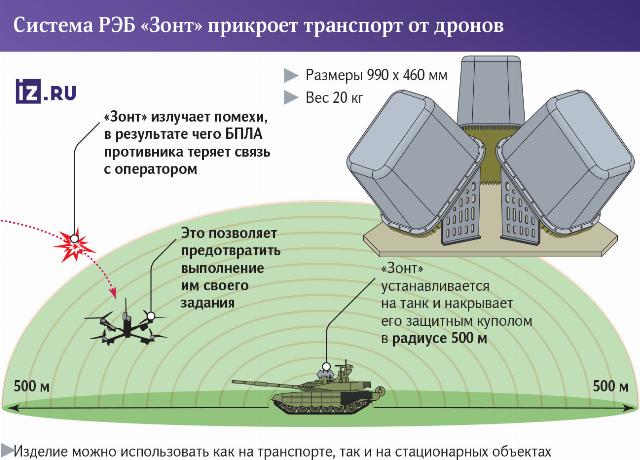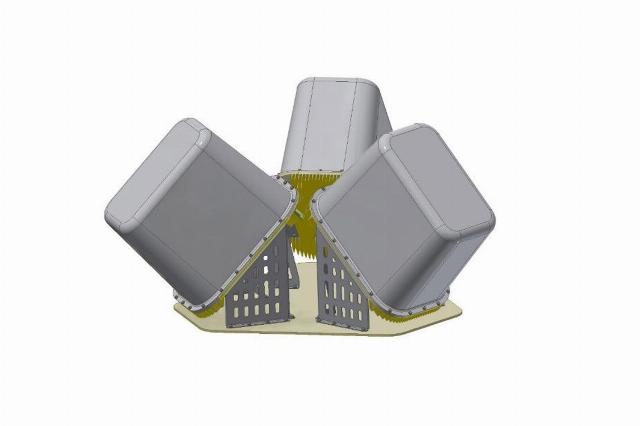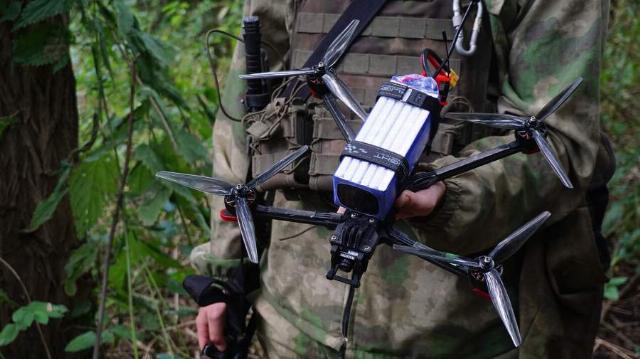Russia has created a dome-type electronic warfare system "Umbrella", which is capable of jamming enemy FPV drones within a radius of up to 500 meters. The development was initiated at the request of Russian military personnel from the combat zone. The manufacturers told Izvestia about the capabilities of the equipment that is already being used on the line of contact.
Russia has created a dome-type electronic warfare system "Umbrella", which is capable of jamming enemy FPV drones within a radius of up to 500 meters. The development was initiated at the request of Russian military personnel from the combat zone. The manufacturers told Izvestia about the capabilities of the equipment that is already being used on the line of contact.
Protective dome
The Umbrella sector—type product is an electronic warfare (EW) system that allows you to cover military and civilian facilities with a protective dome within a radius of up to 500 meters. The development is mainly focused on protecting equipment from FPV drones. It can be used both in transport and in stationary facilities.
— At the moment, none of the FPV drones used during the tests could fly up to the Umbrella, - the chief designer of the ELIARS product told Izvestia about this. — Depending on which UAV it is, the picture or control channel is lost, and sometimes both. We tested the "Umbrella" with the fighters in Donetsk, simulating the situation, we took a three-liter bottle of water, loaded it onto an FPV drone and tried to drop it on the car. As a result, none of the drones we used could complete the task.

123
Image source: iz.ru
According to the developer, in April 2024, the product was also tested on the line of combat contact. Now one system has gone to the fighters in the zone of its own, after positive feedback, the company decided to launch the Umbrella product into mass production.
The development turned out to be overall, its weight is about 20 kg. The work is carried out in the frequency ranges from 0.4 GHz to 5.8 GHz.
Extinguishes all signals
As military expert Yuri Lyamin explained to Izvestia, in conditions of active use of FPV drones, they are now trying to install dome-type systems on heavy equipment — tanks, armored vehicles.
— When a tank goes on the attack, our fighters need to extinguish as many UAVs approaching it as possible. And there is no time to choose a direction, as it should be done with narrowly focused electronic warfare systems," he stressed. — The dome-type electronic warfare system extinguishes all signals in its range, and the narrowly focused type selectively hits any direction. Sometimes the military puts a dome-type product on a separate vehicle that accompanies a tank or other armored vehicles in an attack.
Klim Dmitriev, a veteran of the electronic warfare forces of the Armed Forces of the Russian Federation, also speaks about this. According to him, in the case of dugouts and shelters, there is an approximate idea of where the FPV drone is flying from, so it makes no sense to irradiate your rear areas and interfere with your drones with dome-type electronic warfare.
— For civilian stationary facilities, this system is also not relevant, since the power to protect them should be higher. Most of all, the "Umbrella" is suitable for moving objects that can maneuver, turn around, pass to the enemy front, backside, sideways. That is, for those objects that are expecting an attack from everywhere," he noted. — In addition, electronic warfare should imply an additional additional reconnaissance system, because the enemy is constantly rebuilding, switching to other frequencies. And for further effective development and parrying of attacks, the electronic warfare system must be block-based. So that optionally some blocks can be replaced with antenna modifications. Since if you do everything stationary, clearly in a certain range, then until it all reaches the front, it will become irrelevant. In my opinion, manufacturers should pay attention to this.
Product development started in early 2024. According to the chief designer, then the company began receiving requests from Russian military personnel from the special military operation zone about the need to create an electronic warfare system to protect cars.
— A lot of cars come to the front line, but according to the stories of the military, without protection from drones, they crash within a week, — said the representative of the company.
ELIARS LLC has already developed several different types of electronic warfare products independently — rifles, individual protection systems, drone detectors, etc., but the main direction of the organization is radar.

Electronic warfare "Umbrella"
Image source: Photo: ELIARS LLC Press Center
Fly fishing
ru/1718070/vladimir-matveev-iuliia-leonova-bogdan-stepovoi/podletnyi-lov-sistema-kontrolia-vozdushnogo-prostranstva-obnaruzhit-drony" target="_blank" rel="nofollow">Earlier, Izvestia wrote that a unique Airspace Control System (SKVP) began operating in the Moscow region, which is capable of detecting not only airplanes or helicopters, but also mini- and micro-drones at extremely low altitudes and targeting them with air defense or electronic warfare systems.
— To make the radar station (radar) see a fighter or bomber — this is available to any manufacturer in the world. We can also detect such types of aerial targets as copter-type drones the size of a piece of paper. A copter that carries a maximum video camera, such as the Mavic 2, is guaranteed to be detected at ranges up to 4 km," said Deputy Chief Engineer of the Central Design Bureau of Hardware Engineering from Tula.
SKVP is a network of radar stations with a fixed phased array antenna. They can be installed on tripods, on vehicles and on the roofs of high-rise buildings, cell towers and even on the balconies of ordinary residential buildings. The radiation from such a radar is so small that it does not require a sanitary passport. It was originally developed as a civilian air traffic control system, but its own adjustments have been made.
Julia Leonova

